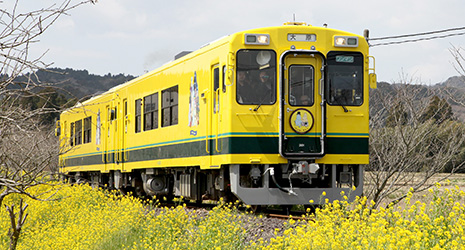Home > Highlighting JAPAN > Highlighting Japan April 2017 > The New Age of Rail
Highlighting JAPAN


Local Railway, Regional Treasure
Faced with the twin challenges of motorization and urbanization, local railway companies have had to be inventive to maintain operability.
The Isumi Line, which connects the Pacific side of the Boso Peninsula and its inland area, extends over a total of 26.8 kilometers and has fourteen stations. The precursor of the Isumi Line was the Kihara Line of the Japan National Railway (currently JR East), which opened in 1930. The Kihara Line went out of service in 1988, but Isumi Rail, which was established through the joint funding of the private sectors and local governments in areas along the railway line, took over the management of the Kihara Line and operated the railway service as the Isumi Line. However, it ran continuous deficits and the local governments hosting the railway discussed whether they should retain or abolish the railway line over a period of two years from 2008 to 2009.
In the meantime, the railway company publicly sought a president, with Akira Torizuka being appointed in 2009. Torizuka is a former British Airways flight service director but also a huge railway enthusiast. He even founded a railway DVD production company as a side job.
“On weekdays, many Isumi Line users are high school students and the elderly. Private cars are even more convenient than railway trains for local people who have driver’s licenses. Even if we ask local people to use railways more frequently, we have no chance,” says Torizuka. “On the other hand, there are about 35 million people living in the Greater Tokyo Metropolitan area. If one percent of them take an interest in the Isumi Line, and those 35,000 people actually use the Isumi Line service, the railway company will be able to achieve successful management.”
Torizuka established a strategy to attract tourists from urban areas by introducing trains featuring the popular Moomin cartoon characters created by Tove Jansson.
“The setting of Moomin has seas, mountains and valleys along its train lines and its image is quite similar to those of the places along the Isumi Line, where you can enjoy tranquil and peaceful country landscapes,” says Torizuka. “In addition, women who were enthusiasts of this animation in their childhood are now in their thirties to fifties. People of this generation enjoy relatively comfortable lifestyles and I guessed that they would be able to easily afford and enjoy trips using the Isumi Line.”
This campaign was successful. The number of Isumi Line users increased and it was decided that the railway line would continue to operate in 2010. But because regular users, including high school students, continued to decrease every year, Torizuka continued to run one campaign after another to attract tourists. In 2013, he started to run restaurant trains that provide cooking and sweets using local foods on the weekends. In 2015, the company also introduced two fifty-year-old diesel trains featuring nostalgic colors of that time. You can say that Torizuka changed the idea of being a “local country train” into an attractive brand.
In recent years, the Isumi Line has been vibrant with senior couples, families with small children and railway enthusiasts carrying cameras on the weekends. In addition, at Otaki Station, where the head office is located, there has been an increasing number of people who enjoy walking around the quiet castle town before changing trains.
“The number of passengers, excluding regular users, is increasing at an annual rate of five to eight percent. What pleases us more than anything else is that the increase in the number of passengers is also leading to regional revitalization,” says Torizuka. “From now on, we will also carry out collaborative initiatives to increase the brand appeal of local agricultural and marine products.”
According to Torizuka, the increasing popularity of the Isumi Line is heightening local people’s interest in the railway and they have become more positive about protecting the local railway, which is still in the red.
“The local railway is a regional treasure,” says Torizuka. “Our local community is just dozens of kilometers away from the central area of Tokyo, but you can still feel the real breath of the Japanese countryside along the Isumi Line. We sincerely hope that foreigners who are tired of the same old trips will visit us.”
© 2009 Cabinet Office, Government of Japan







